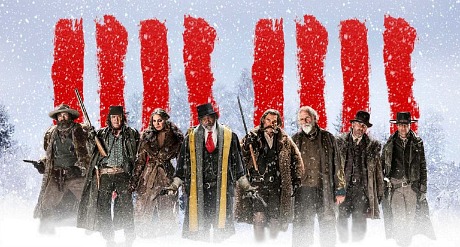Nothing specific is revealed here but spoiler whiners will bitch anyway…just saying: Until this morning the review-embargo date for Quentin Tarantino‘s The Hateful Eight was 12.21 — i.e., next Monday. But this morning Weinstein Co. reps called or mass-texted a bunch of trades and gave them the green light. Screen International‘s Tim Grierson ran first with a review, followed by Indiewire‘s Eric Kohn. And then all of them Rotten Tomatoes wordslingers jumped in. In my book that means HE is good to go also, right? Except I’ve been taken by surprise. I got nothin’, ma. Haven’t written a damn thing. 12.21 isn’t for another five and a half days.

So I’ll just say this: The Hateful Eight is, as Kohn says, more or less Reservoir Dogs meets Django Unchained but it’s mainly about archetypal flavor and macho swagger, archetypal flavor and macho swagger and more archetypal flavor and macho swagger. Which is what you always get from Tarantino, and why his films have continued to be popular. Because people like that shit. They revel in QT’s patented, talky, menacing-fellows-doing-a-slow-boil thing.
And with the exception of what struck me as needlessly repetitive sadistic beatings of Jennifer Jason Leigh‘s outlaw character, The Hateful Eight delivers a relatively engaging (and sometimes more than relatively) first two-thirds. If you have a place in your head for this kind of thing, I mean. Which I do to some extent. I was a big fan during Tarantino’s ’90s heyday, I mean, and I can still find ways of succumbing to his material as long as I use a filter, although I started to tune out bigtime with the Kill Bill films and came back in only briefly with Death Proof.
The Hateful Eight serves a nice warm bowl of Tarantino soup. A sense of place and mood and attitude that feels relatively well developed and whole. You get beautiful-as-far-it-goes Ultra Panavision 70 photography. You get tasty, savory performances from Samuel L. Jackson, Kurt Russell and Walton Goggins in particular. You get about 45 minutes of snowblindy outdoor footage followed by two-plus hours inside a large, shadowy one-room cabin (i.e., Minnie’s haberdashery). You get a “Lincoln letter” that delivers a sense of morality and decency in the world beyond and a suggestion that lingering Civil War-era hate and prejudices are likely to erode. And a lotta boom boom boom.
You’re sitting there watching this Tarantino thing and you’re also saying to yourself “Yup, this is definitely a Tarantino thing.” You know what it’s more or less gonna be (including a fair amount of violence and blood), and it more or less does that.
And then comes the final third, which is basically about killing for the sake of the roar of gunfire and after-aroma of gunsmoke, and served with what felt to me like sadistic relish. Character after character gets shot and hits the floor, over and over and over and over, and Tarantino gives into this mayhem with such a lack of discipline that you quickly recoil as you ask yourself “what the fuck’s going on here?” Few of the killings seem necessary except to fulfill some kind of perverse quota that says “people have to get shot in westerns.” Tarantino seems to believe that this or that character eating lead automatically ups the intrigue or excitement factor.
In my book all shootings have to be “earned” — they have to be necessary and desired or they’re just noise. I don’t care if this in keeping with the perverse value system of critics like David Ehrlich — shootings can’t just be firecrackers going off. They have to mean something. It felt right and just when William Holden, Ernest Borgnine, Warren Oates and Ben Johnson shot Emilio Fernández full of holes at the end of The Wild Bunch. Or when Alan Ladd drilled Jack Palance and Emile Meyer and John Dierkes during the finale of Shane. Or when Grace Kelly shot Robert Wilkie in High Noon. These were welcome and satisfying, but not so much in The Hateful Eight.
Basic verdict: I’ve spoken to people of some taste and refinement who like and even love The Hateful Eight, but if you ask me they’re being awfully damn perverse in their enthusiasm. Regional critic: “Saw it today. All of Tarantino’s worst tendencies wrapped up in one awful film. Too long, too wordy. Dull, sadistic, pointless. And why bother with 70 mm Panavision when 80% of the film is inside a roadhouse?”









